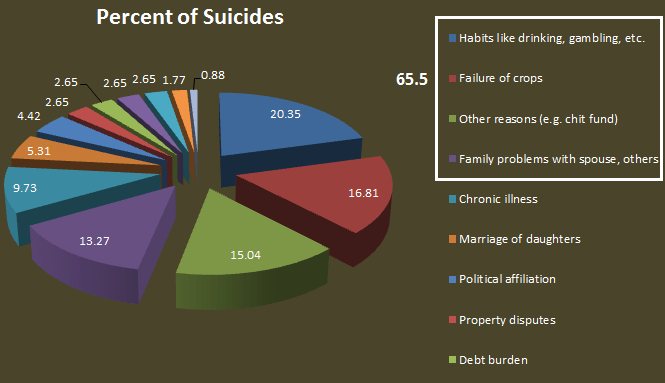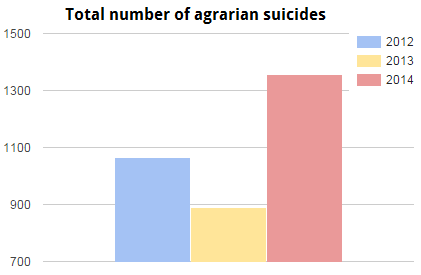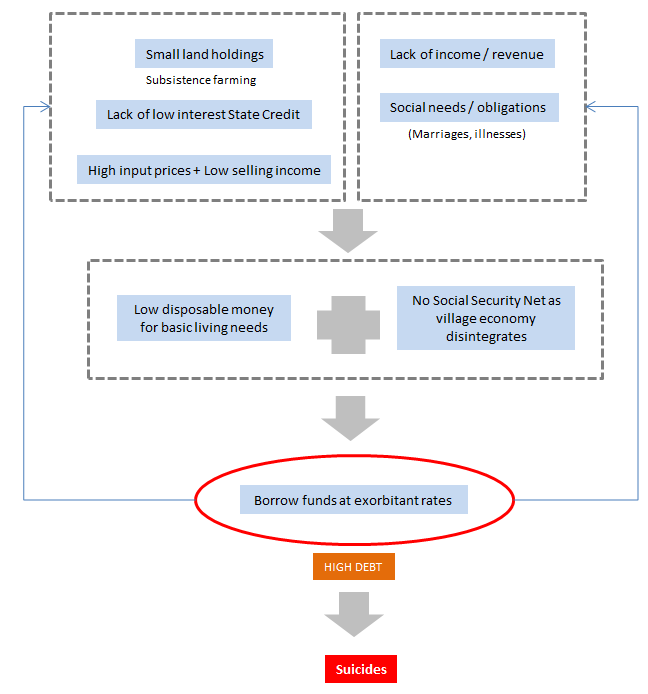The DeepSeek Jolt: The Technological, Economic, and Geopolitical Impact
China's AI Open Source model - DeepSeek R1 has shaken the tech and geopolitical world. It has ramifications in many areas. We have analyzed every aspect of its impact.

When Palagummi Sainath, an Indian journalist, went to Vidarbha, the cotton-growing region of Maharashtra he found a strange phenomenon. He found that the farmers committing suicide were leaving suicide notes. And these suicide notes were not addressed to their family members but to India’s Finance Minister and Prime Minister. Why? Because of critical economic reasons for which the government had done little.
Sainath found that indebtedness was the main reason for the suicides.
“[E]very suicide has a multiplicity of causes,” said Sainath, “but, when you have 300,000 . . . in the same occupation within a compressed period of time, then you want to start looking for. . . the common factors.”
The journalist identified indebtedness as the “central driving factor behind the suicides,” noting that agricultural costs had increased greatly following the implementation of neoliberal agricultural policies.
Sainath has found that due to how India’s finance ministry has redefined the agricultural sector, low interest or no interest loans available from state earlier. The prices for inputs have increased and credit is not available to small farmer as it has all been geared for the large corporate farmer.
Farmer suicides, said Sainath, are a tragic consequence of this rising corporate dominance and the transfer of credit and other resources to the wealthy elite.
Although they are the largest group of landed small farmers in the world, Indian farmers have no control over the prices of the seeds, pesticides, fertilizer and water that they need to operate their farms, or over the markets to which they sell.
And while higher sale prices have resulted from government policies, Sainath argued that market-based pricing had also caused a multifold increase in agricultural costs. At the same time, new credit policies have encouraged the corporatization of the agriculture sector.
Previously, priority sector lending by the state and differential rates of interest allowed poor farmers to obtain loans with little to no interest. Over the last 15 years, however, India’s finance ministry has redefined the agriculture sector so that small farmers now see very little of these priority sector loans.
Over the period of 2004 to 2006, many studies were done which identified the following issues:
Attack on Government for Farmer’s Suicides
The attack on the Modi government follows a very simplistic argument – Everything is because of the government and the Modi government isn’t doing what’s needed (nobody says what that is) and its not cool anymore to blame Congress and Left’s 60 years of failed policies.
The truth based on facts is however much more complex. In his celebrated book, “India: The Emerging Giant”, economist Arvind Panagariya cites studies which give the break-up of the reasons for the suicides that happened. Farmers’ family members gave more than one reasons for the suicides, which is consistent in other studies as well. Here is the break up:

As per these studies, the farm related reasons account for just 25% of the suicides.
And, that is the reason why the deaths are confused in the rural areas. There are genuine agrarian related deaths and then there are the rural deaths. The agrarian deaths are just a fraction of all the rural deaths as per the statistics! While the total number of deaths run upto 300,000; the agrarian deaths stand at 3313.

If one were to look closer, one finds that it is NOT farmers suicides that we are talking about, it is the suicides of the rural poor! Rural poor suicides IS a serious issue. So, are farmers’ suicides whatever the numbers. But we need to understand the issues in proper perspective
This is what our rural poor are facing:
Social issues: Drinking, drugs, property disputes, family disputes, marriages, illnesses
Financial issues: Indebtedness, chit fund, gambling
Agrarian issues: High input prices, adverse selling infrastructure, GMO seeds, corporate farming and large farms monopoly.
If one looks at all these, one finds that even the social issues are either offshoots or triggers for the financial crisis. What we have in our country is a Suicidal Spiral in Rural India!

If one were to look at this spiral, one can easily see that interventions to stop the extremely sorry situation of the rural poor have to happen at many levels and many different points.
What has the Modi Government done?
Let us “cut the crap” and be honest, opposition to the current government is less of “activism” and more of hatred-in-action! There is no real reason why doing a dharna or opposing the government “for the heck of it” will help the nation and the state of the rural poor in any way.
Let us understand what this government has done to alleviate the situation:
1Salvaging WTO Weak Stance: India had almost given away all the bargaining chips to the developed countries in the critical area of food stockpiling, where the governments stockpile food – even when it is not required – at a reasonable enough price, to help the poor farmers. This one clause was very important for India’s ability to help the poor farmers’ interest be not completely sold out in face of the machinations by the developed world.
What did the Modi government, specifically Nirmala Sitharaman do in the WTO talks in Geneva in December 2014?
The WTO General Council, at its meeting in Geneva on Thursday, had accepted India’s demand for extending the peace clause till a permanent solution is found for its food stockpiling issue. The peace clause prevents any WTO member-nation from challenging public stockholding of food grains by developing countries for food security purposes.
As per the agreement reached at the Bali Ministerial Meeting in December last year, the peace clause was to continue only till 2017. “The WTO decision strengthens the safeguard available for continuing the Minimum Support Price policy which is a lifeline for millions of our low-income, resource-poor farmers,” Sitharaman said.
If we are talking of poor and small farmer in India, then liberating him of the shackles that the developed world was going to put on him have been opened up, indefinitely – as opposed to only until 2017 as earlier discussed! That was the first step.
2Cutting out the middleman: Money money everywhere, not a penny for the poor. Mahatma Gandhi National Rural Employment Gurantee Act or popularly known as MNREGA, is a dole-out scheme for the rural poor. Under this scheme, poor are asked to do some rural project – often some ridiculous one like digging a canal – to be paid money. The amounts that have been budgeted for last so many years have been to the tune of $20 billion per annum!! Yes, that is in US Dollars and that is billion with a B! So much of money was doled out every year, but apparently a fraction reached the poor. The rest – as per CAG 97% of it – was usurped by the middleman. It is not that poor can’t be given enough for their living, the problem is that that money doesn’t reach them! So, how does the government with good intentions and money in hand reach the poor directly?
Bank accounts for the poor? Sounds like a good idea, but we have millions of rural poor. Well, then make it a movement!! A movement where the local banks are brought into the act of opening bank accounts in the rural areas. The result – almost 88 million bank accounts in rural areas (total 147 million) have been opened. And people have even deposited moneys into them to the tune of Rs 157 billion!! Here is the important element of the bank accounts that were being opened – Account holders will be provided zero-balance bank account with RuPay debit card, in addition to accidental insurance cover of Rs 1 lakh(to be given by ‘HDFC Ergo’). Since calamities, deaths and accidents are one of the major reasons why so many families go into debt, a free insurance cover helps as well!
A huge hullabaloo was created over 85 million accounts that are still with zero balance – “what’s the use?” came the retort. Well, does it need a rocket scientist to understand that now, the government has the exact vehicle to cut the middleman? If this one simple action and strategy can effectively put the $20 billion in the pockets.. err zero balance bank accounts of the rural poor, then shouldn’t one marvel at the brilliance? Isn’t financial issues the main issue that we are fighting for rural poor?
More importantly, by creating another feature – the government has created a lending relationship between the poor and the public sector banks. That is – after Six months of opening of the bank account, holders can avail 5,000 ₹ overdraft from the bank. To understand why this is critical one needs to refer to the suicidal spiral and the most important and critical reason for suicides – Indebtedness! Admittedly, this isn’t much, but it is a start in the right direction. With the creation of the platform, we now have a way to go forward and do what needs to be done.
This was the obvious second step to mitigate the plight of the rural poor that drove them to commit suicides.
3Creating Alternative Income Opportunities and Land Acquisition Bill: For this, one needs to set aside a mind steeped in prejudice and colored propaganda by the media / political parties and look at the provisions that are sought to be changed and why for what they are worth! But first let us get some background to know why this aspect is such an important part of reducing and mitigating farmer suicides that Modi government is not willing to compromise, lunacy of the political opposition notwithstanding.
A detailed investigation by some UK researchers found the following to be the main reasons for suicide:
Investigations by researchers from the Cambridge University’s Department of Sociology and University College London’s Department of Political Science has found that rates of suicide are highest in areas with the most debt-ridden farmers who are clinging to tiny smallholdings – less than one hectare – and are trying to grow cash crops such as cotton and coffee that are highly susceptible to global price fluctuations.
Farmers at highest risk have three characteristics: those that grow cash crops such as coffee and cotton; those with ‘marginal’ farms of less than one hectare; and those with debts of Rs 300 or more. States in which these characteristics are most prevalent had the highest suicide rates. These characteristics accounted for almost 75% of the variability in state-level suicides.
Even P. Sainath, perhaps the Indian researcher who has done the most work on farmers suicides says the same thing:
A big problem as per Sainath has been that because of globalization and extreme privatization (the latter may be an extreme view, for private corporates can be detrimental – monopoly of cotton seeds in Mahyco is an example, but it can be good also if it gives farmers better prices and assured purchase of their crops – through say contract farming), difficulty in getting loans, high rates of interest, high intensity of cash crop plantation leading to severe water stress like say sugarcane in Maharashtra, and other kinds of dubious policy decisions like making alcohol from rice over using rice to feed the poor or letting it go to market in Maharashtra, all these kinds of decisions have made the farmers believe that the government is not going to solve their problems. And with the climate playing truant more often than not, I guess the hopes of farmers may well be receding.
The Land Acquisition Bill brought out by the Modi government aims to impact the rural unemployment and poverty situation by opening up ways to use the land in rural areas for industrial development.
Here is a list of the changes that are being brought in:
These changes are over and above the earlier amendments moved through an ordinance where the government had added five sectors (defence, rural infra, affordable housing, industrial corridors, infra and social infra projects including PPP) to a list that would not require owners’ consent while acquiring land as well as exempted them from submitting a social impact assessment (SIA) and removal of restriction on acquisition of multi-crop lands for these sectors. The last social infra projects including PP have been removed from the exemption list.
Most of the criticism to these changes that are being brought about by the bill voiced by different characters seems superficial and uninformed. Here are some of the reasons why:
MOST PROJECTS under these heads will be govt-led or govtinspired & belong to key infrastructure & security areas that increase public good. Spectre of business baron profi teering out of sarkari munifi cence doesn’t quite apply.
FOR EVERYTHING else, the Modi land law and the Congress land law is the same. So, there’s no special favour to business there.
Ok, Even if Rich are not being especially Favoured, is Modi Law Still Hurting Poor?
THIS CENTRES on removal of the SIA and 80% consent rule from those 5 areas. But consider, first, that SIA’s ambit in the Congress law is so broad that for critical projects in infrastructure and security, calculations can go on endlessly and costs can really go up. And the 80% rule means, hold outs by a few landowners can cause major delays in big, necessary projects.
THEREFORE, THIS is a compromise between social and economic policy imperatives. For a car factory, there’ll be SIA. But, for say, a rural electrifi cation project or an apartment block for low-income people or a project like Delhi-Mumbai industrial corridor, there won’t be a SIA.
PLUS, NO compromise has been made on compensation formula. Farmers, on whose behalf every political party is agitating, get 4 times the market value of land they own.
ALSO, MODI law brings in 13 areas not covered by the Cong law and landowners will now get high rates for compensation for land acquired for coal & mining projects, metro construction, nuclear projects, roads, etc.
So, if one looks at it closely – one of the big goal of the bill is not just to open up the land for better returns and opportunities for livelihood. Which is what the small farmers and their progeny may REALLY need!!
As for how the “private companies (aka Sharks)” will usurp the poor farmer’s land and leave them poor? Remember the Nano plant? How Mamta Bannerjee had raised a huge hue and cry to force Tatas to close the plant in Singrur – because of this very argument? Well, in Modi’s “communal Gujarat”, where Tata moved its Nano plant to, the story was a very interesting and arguably a much happier one!
Remember the Nano plant which Gujarat snatched from the lazy Bengal? Well, the land given to them was next to a majority Muslim village. At that time, the land prices there were Rs 400,000 a hectare. Now, in just 6 years, the prices have risen 25 times to Rs 1 crores a hectare. This is not just the “Market Price” but the price at which the Government is buying the land from the farmers. What does this mean for ordinary folks?Bashir Khan Pathan (28), a farmer, is expecting close to Rs 10 crore for his 9.5 hectares. Among other imminent crorepatis are Samratkhan Pathan who is looking at a figure of Rs 3.92 crore andMohammad Hanif Rajpura who hopes to get Rs 1.65 crore.And, no one had to do anything specific for any one group. Just make development happen indiscriminately. And everyone benefits!Talati of Kalana village Hari Jadav said, “After Muslims, the main beneficiaries will be Thakore and Bharwad communities.”It is obvious what the Congress and the BSPs, SPs etc do and what Modi does. By throwing Nano out, how the heck did Mamata Bannerjee think that she can give enough food on the table for anyone, forget the Muslims?Image source: Flickr